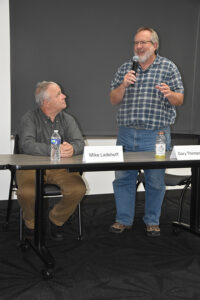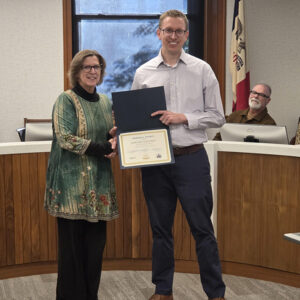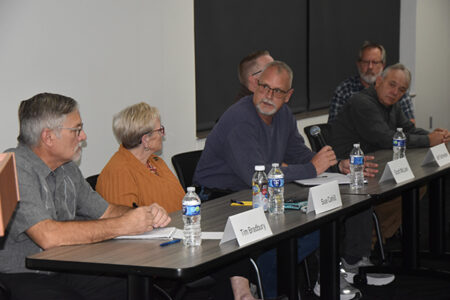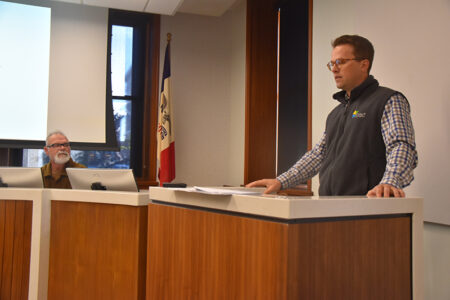City council candidates address economic aspects
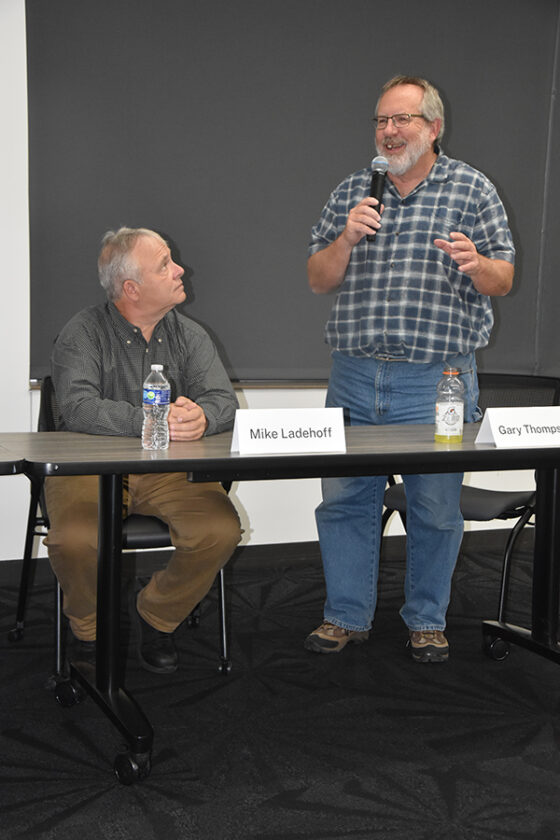
T-R PHOTO BY LANA BRADSTREAM Mayoral candidate Gary Thompson answers a question regarding the Marshalltown Mall tax increment financing (TIF) as fellow candidate Mike Ladehoff listens. They were joined by four at-large Marshalltown City Council candidates for a candidate forum at the Marshalltown Public Library.
(EDITOR’S NOTE: This is the second part of a series about the Marshalltown Candidate Forum featuring city council and mayoral candidates.)
Six candidates met at the Marshalltown Public Library on Wednesday for the Marshalltown Candidate Forum. Four candidates – Tim Bradbury, Sue Cahill, Scott McLain and incumbent Jeff Schneider – are running for two at-large Marshalltown City Council seats. Whichever two candidates get the most votes at the Nov. 3 election will receive the seats.
The other two candidates — Mike Ladehoff and Gary Thompson — are running for mayor. Both are experienced city council candidates. Ladehoff is currently the mayor pro-tem and represents Ward 1 on the council. Thompson is an at-large councilman.
Marshalltown Area Chamber of Commerce President & CEO John Hall asked the questions during the forum, and some of those focused on aspects of the economy, including growth of the town and the city’s usage of TIF (tax increment financing).
He said Marshalltown has more than 14,000 jobs and 57 percent of the people holding those jobs commute. Hall asked how the candidates would reduce the commuter rate, thus having more of those workers living in the community.
McLain answered first by addressing the lack of affordable housing. The median Marshalltown household income is $68,000 to $72,000, which does not support a $300,000 home.
“We’ve got to build or find the developers that are willing to build the $150,000 to $200,000 homes,” McLain said. ” . . . The other thing we have to overcome is our shopping opportunities and retail capabilities. They’re going to commute, because that’s also where they do their retail.”
According to Schneider, those commuters are more likely to afford the $300,000 homes. The city just needs to get them to build in Marshalltown. The reason they are commuting, he said, is they see a quality of life opportunity in other communities. Marshalltown needs opportunities to increase activities for residents.
“Projects to do with families,” Schneider said. “Things like here at the library. We’re lucky to have such a great library and great programming, but I know that’s what people are looking for, especially young families.”
Focusing on those opportunities will make Marshalltown more desirable to the commuters and outside families, and make it more likely for them to relocate here. Schneider said then companies will follow because businesses go where talented people live.
According to Ladehoff, the city has an ongoing housing study, which he is confident will show the community needs all levels of housing. He suggested utilizing a template to make it easier to build.
Thompson said the million dollar question is how to bring jobs and people to Marshalltown. Stating he has a degree in housing, Thompson said he is the person to talk to when it comes to growing Marshalltown.
Bradbury said a pet peeve he has is businesses not hiring locally, and knows many jobs are available online.
“When they do that, that leaves a lot of our local people without a job or being to support the city or help Marshalltown grow,” he said. “I asked why. They said there is no law that makes them prioritize hiring locally, and that really disturbed me. That just causes a lot more problems or helps create more problems for people if they can’t get jobs. . . . I’d like to somehow see that changed.”
Cahill, who is a former Marshalltown City Council member and state legislator, said if the city could provide incentives through the businesses that employ many of the commuters.
“I think we need to think broadly about how we can provide some incentives that not only invite them to be here, but through their employers, to invite them to stay here and sleep here,” she said.
Mall TIF
Hall asked about the $7.2 million TIF the city gave to Reserve Development, the Marshalltown Mall owners. The redevelopment of the mall is the largest private investment going on. Hall asked the candidates to use detail in explaining their position on the mall project and the city’s use of TIF to attract the development.
Ladehoff said the mall was dead for eight to 10 years. Then the Chamber found someone willing to invest $36 million into it, and bring new stores to town. He said the TIF will last 20 years, and the city will reclaim more of the tax money as it goes.
“The money that goes to the developer goes back into the project and helps him finish and make that project whole,” he said. “Nothing comes out of the city budget. Nothing. Okay? It’s nothing but a win for us and it’s a win for Marshalltown.”
Thompson said he has not seen the figures which prove the city will be getting the $7.2 million back. He voted against it because TIF should be used as an incentive to attract development. However, the mall TIF was done backwards as Reserve Development had already purchased the property.
“They already had a plan in place,” he said. “They already supposedly had some people contacted to be there, and then after the fact we awarded them with a $7.2 million abatement. I was OK with that, if we would have just called it what it was, but creating a TIF plan was not an incentive. It was a reward for them buying it.”
Bradbury said while the TIF is not taking from the taxes, it is also not adding to it. With the city hurting for revenue, he said too much burden is placed on seniors and residents and there should be ways to fix the problem. Another reason he is against the TIF, is because if a project cannot stand on its own, then it should not be in the town.
“Malls seem to go in 20-year cycles or 30 years, whatever,” he said. “It doesn’t seem like they’re long term.”
Cahill supports the TIF because an empty building provides zero in tax revenue. The town will benefit when visitors shop at the Marshalltown Mall then stop to get gas and eat a meal.
“We are going to benefit in ways that are directly related to that tax benefit through the TIF,” she said. “We need to look at the big picture. I think this was a good move for the community.”
McLain said he is torn because he has seen good and bad TIFs. There are good qualities in the mall TIF, but he wondered if the requirements will be enforced.
“If they don’t meet it, it needs to go,” he said. “But TIF is great to bring development to us, help us. . . . I think it can be capitalized correctly, but I think we also have to enforce that there’s some enforcements that need to happen. There’s requirements that have to happen. They shouldn’t just get free money and not meet the requirements.”
For example, if a TIF-receiving developer agrees to a requirement of bringing 50 jobs to the community, but then only provides 20, that is a problem, McLain said.
Schneider said the mall TIF was one of the easiest votes he ever faced. While Reserve did buy the property ahead of time, the level of planned redevelopment would not exist without the TIF.
“I think coming here, they knew that a TIF deal was possible, so that was part of the equation of them actually purchasing the property,” he said. “The taxpayer in Marshalltown is paying nothing for this. . . . The deal is structured in such a way that there’s no losing. There are certain measures that they have to meet in order to get their payments. So, that was very easy. I think TIF is a great tool to attract new development, and I will continue to use it.”
——-
Contact Lana Bradstream
at 641-753-6611 ext. 210 or
lbradstream@timesrepublican.com.


